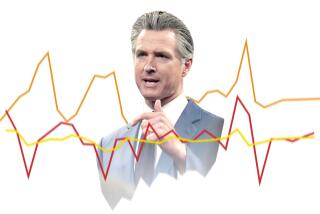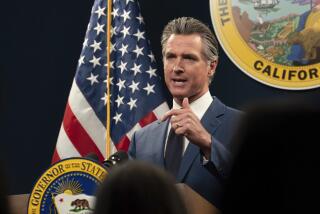Federal funds may not stave off classroom cuts, California educators say
- Share via
California education officials, girded by the nationwide release Wednesday of $44 billion from the federal economic stimulus plan, are nevertheless worried that the state’s share won’t be enough or come in time to stave off widespread teacher firings and program cuts.
More than $4 billion of the money is expected to flow into California coffers in the first round of education funding from the stimulus package passed in Washington earlier this year.
“The speed with which it gets to us is critical, and that’s largely dependent on the governor and the Legislature getting it out the door,” said Charles Weis, superintendent of schools in Santa Clara County and president-elect of the Assn. of California School Administrators. “Given the cuts we’ve experienced in education this year, this won’t even get us back to where we were last year. Best-case scenario, a portion of [the layoffs and cuts] will be rescinded.”
“Every day is crucial for schools right now,” added Darline Robles, Los Angeles County superintendent of schools.
The stimulus plan provides $81.6 billion for pre-K through high school programs throughout the nation. California’s full share is expected to be $8 billion, potentially more if the state is successful in seeking competitive grants. On Wednesday, Education Secretary Arne Duncan released the first round of funding, with two additional rounds expected later this year.
California will soon receive $562 million for its neediest students and $634 million for special-education students. School districts will learn their share of those amounts in early May. The state must apply for its projected $3.1-billion share of “stabilization funds” that are intended to save teacher jobs and invest in education. That should take two weeks, and the federal government is expected to respond by mid-April.
California school and community college budgets were cut by $7.4 billion this year and will be cut by $3.2 billion next year under the state spending plan approved in February. Although the federal money will provide some relief, several variables in the coming weeks will determine whether California schools face further cuts.
In April, the state will begin receiving income tax receipts, which could be lower than normal because of the economy. On the May 19 ballot, two propositions would provide more than $9 billion for schools if voters agree to allow certain tax increases to be extended.
If voters don’t approve other measures involving the state lottery and public health and mental health spending, the Legislature will have to plug a $5.8-billion budget hole. In May, the Legislature will revise the budget based on these factors as well as new economic forecasts, which already show the state facing an $8-billion gap next year.
“We know there is a downside risk,” said H.D. Palmer, spokesman for Gov. Arnold Schwarzenegger’s finance department. “Under the theory you should hope for the best and plan for the worst, we have begun to scope out potential options for different solutions if we need them.”
School superintendents, who have given preliminary pink slips to more than 30,000 teachers and administrators, fear that one of the solutions to the state’s ongoing fiscal problems would be to tap into the federal stimulus money to make up shortfalls.
The nonpartisan Legislative Analyst’s Office last month suggested holding back some of the federal money until the state’s budgetary picture becomes clearer. These fears prompted members of California’s congressional delegation to send a stern letter to Schwarzenegger and other state officials warning them to use the money as directed.
Making sure the money is used as intended is a concern echoing in state capitals across the nation, leading Duncan to warn states and governors against playing “shell games” or acting in “bad faith.”
“We’re holding back literally billions of dollars for the second round of funding,” he said. “States that aren’t doing the right thing will basically eliminate themselves from competition.”
Duncan is also tying the first round of money to states committing to the Obama administration’s education goals, such as developing programs that improve teacher effectiveness, boost achievement in low-performing schools and track student achievement and teacher performance.
To qualify for the second round, states will be required to reveal detailed data such as how students perform on state tests compared to more rigorous federal assessments, whether students have access to quality teachers, particularly in high-poverty areas, and whether state intervention into failing schools is working.
In the third round of funding, Duncan intends to reward states that used earlier money to create innovative solutions to improve student performance with a $5-billion “Race to the Top” fund. Examples could include increasing school hours, or developing programs in which states work together to create rigorous common standards, rather than having each state set its own.
California officials have already started speaking with other states about creating aligned high standards in core areas, said state Supt. of Public Instruction Jack O’Connell.
“He’s big on that, I got the signal,” O’Connell said, referring to Obama.
--
More to Read
Sign up for Essential California
The most important California stories and recommendations in your inbox every morning.
You may occasionally receive promotional content from the Los Angeles Times.











